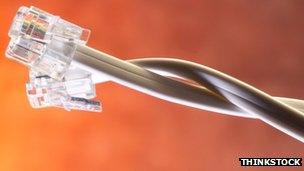IPv6: Trillions of new net addresses now possible
- Published

The new system will run concurrently with the old for the next few years
A new standard which will allow the creation of trillions of new internet addresses has been enabled.
Several companies switched to Internet Protocol version 6 (IPv6) at 00:01 GMT on Wednesday.
The new system is necessary to prevent the internet running out of available addresses for new devices.
Experts said users should not notice any difference in their web use, and new devices should be using the new system as standard.
Companies such as Google, Facebook and major internet service providers have enabled the new system in order to encourage the widespread adoption of the standard.
The actions come as part of <link> <caption>World IPv6 Launch Day</caption> <url href="http://www.worldipv6launch.org/" platform="highweb"/> </link> , a special event organised by the Internet Society.
IPv6 will eventually replace IPv4, which was conceived during the early days of the internet. It only allows just over four billion unique IP addresses - the sequences of numbers used to identify a device.
Each internet-enabled device - such as a computer, tablet or smartphone - needs its own IP address in order to connect to the internet.
However, due to the shortage of IP addresses, many devices - such as multiple computers in the one home - have to share addresses.
Networking giant Cisco predicts that by 2016, 18.9 billion internet-enabled devices will be online. Switching to IPv6 means trillions of possible addresses can now be made.
Vint Cerf, early pioneer of the internet and current "chief internet evangelist" for Google, <link> <caption>explained in a blog post</caption> <url href="http://googleblog.blogspot.co.uk/2012/06/world-ipv6-launch-keeping-internet.html" platform="highweb"/> </link> : "The new, larger IPv6 expands the limit to 2^128 addresses—more than 340 trillion, trillion, trillion! Enough for essentially unlimited growth for the foreseeable future."
'Imperial to metric'
To ensure a smooth transition, and to make sure devices do not stop working, both systems will work side-by-side for the next few years.
"Most users shouldn't notice anything," said Leo Vegoda from the Internet Corporation for Assigned Names and Numbers, which manages the Internet address system.
"If ordinary Internet users need to know stuff, then the technology isn't right."
Some users on IPv4-only devices may experience speed issues, he added.
Once the full switch to IPv6 has been made, older devices and networks may encounter problems.
"The introduction of IPv6 is the IT equivalent of the move from imperial to metric for measurement; the two can run side by side but aren't compatible with each other," explained Mark Lewis, vice president for development for telecommunications firm Interoute.
Mr Lewis warned that the proliferation of internet-enabled devices presents a pressing security risk for companies.
"The introduction of IPv6 will effectively mean that every device, from the mobile phone to the vending machine could become a mole in the office," he said.
"This puts the onus on organisations to secure and understand these new internet enabled devices that operate within the office walls."
- Published4 May 2012
- Published8 March 2012
- Published8 March 2012
- Published11 November 2011